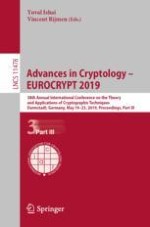2019 | OriginalPaper | Buchkapitel
New Techniques for Efficient Trapdoor Functions and Applications
verfasst von : Sanjam Garg, Romain Gay, Mohammad Hajiabadi
Erschienen in: Advances in Cryptology – EUROCRYPT 2019
Aktivieren Sie unsere intelligente Suche, um passende Fachinhalte oder Patente zu finden.
Wählen Sie Textabschnitte aus um mit Künstlicher Intelligenz passenden Patente zu finden. powered by
Markieren Sie Textabschnitte, um KI-gestützt weitere passende Inhalte zu finden. powered by
Abstract
-
The first construction of deterministic-encryption schemes for block-source inputs (both for the CPA and CCA cases) based on the Computational Diffie-Hellman (CDH) assumption. Moreover, by applying our efficiency-enhancing techniques, we obtain CDH-based schemes with ciphertext size linear in plaintext size.
-
The first construction of lossy TDFs based on the Decisional Diffie-Hellman (DDH) assumption with image size linear in input size, while retaining the lossiness rate of [Peikert-Waters STOC 2008].
